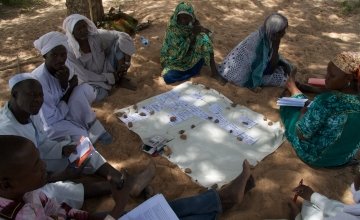
Read our 2023 annual report

Knowledge Hub
Conflict often breeds disaster. So why is it neglected in Disaster Risk Reduction?

As part of our 'Thought Leadership' series, Alexander Carnwath, Concern's Humanitarian and Resilience Senior Policy Officer, questions why conflict is excluded from the Disaster Risk Reduction agenda and points the way forward to a greater focus on fragile contexts.
In a year which began with warnings of famine in four of the most fragile and unstable parts of the world, the suffering caused by conflict has been impossible to ignore. In all four food crises (Somalia, South Sudan, the Lake Chad Basin and Yemen), hunger was not simply the result of failed rains or harsh environmental conditions, it was caused in large part by long-running conflicts which have destroyed people’s livelihoods and forced them from their homes.
The elephant in the room
So you might have expected conflict to be high on the agenda, when states met in Cancun earlier this year for the Global Platform on Disaster Risk Reduction (DRR), a high-level policy event discussing actions to reduce the impact of disasters. Instead the subject was conspicuous by its absence. Conflict has long been the elephant in the room at global DRR meetings, and does not receive any mention in the Sendai Framework for DRR, the main international policy process on reducing risk and building people’s resilience to disasters.
This failure to fully address conflict also extends to investment and implementation in DRR. Although the statistics paint a stark picture of the level of vulnerability – between 2004 and 2014, 58% of deaths caused by disasters occurred in countries that are among the 30 most fragile states – funding and programming has not followed.
So why is this, and how can we encourage a greater focus on conflict and conflict-affected parts of the world? In a new report, launched on 13 October by the Overseas Development Institute (ODI) and Concern, ODI's Katie Peters spoke to DRR policy-makers, donors and practitioners to better understand what is behind this collective reluctance and propose recommendations to address it.
The challenge of DRR in fragile states
Among the reasons given were that conflict is too political and contentious to be included in the Sendai Framework; that it is harder for states to reach agreement and make commitments if conflict features in discussions. There is also a perception among some that governments of conflict-affected countries are unwilling or unable to engage in DRR, despite the fact that many of them have signed up to global DRR agreements. But there also seems to be an ongoing assumption by many that doing effective DRR in fragile states – some of the most dangerous and inaccessible places in the world – is just too challenging, and that staff capacity and overstretched development and humanitarian budgets would be more effectively directed elsewhere.
Here the experience of Concern – one of a relatively small number of organisations working to deliver DRR in fragile contexts – can help point a way forward. In the report, we share our experience of working in three such places: Chad, Somalia and Haiti (all three are countries listed in the Fragile States Index 2017), examining challenges and what we have been able to achieve.
The picture that emerges from these programmes does not downplay the difficulties of working in fragile contexts. In Chad, where we have been collaborating with the government on an Early Warning System, lack of government capacity and resources especially at local level has proved a major challenge to sustainability. In Somalia, the changing dynamics of the conflict between armed groups and African Union-backed forces means that an activity as apparently straightforward as installing a borehole can risk influencing the frontline of the conflict, and compromising our neutrality. And before our programme began in Haiti, in 2009, the intensity of gang violence in Martissant, a heavily populated district south west of Port-au-Prince, was so high that getting access to vulnerable communities was impossible.

Success is possible
Yet through our programming, Concern has found a way to negotiate these issues and our DRR programming has had some successes. In Chad, we are starting to build skills and strengthen the connections between disaster-affected people and government. In Somalia, the impact of our activities – such as training in fodder cultivation – has helped to support vulnerable people through the current crisis and prevent the need for them to leave their homes in search of food. And when Hurricane Matthew struck Haiti in October 2016, community committees, which had been supported by our DRR programme, played a key role in ensuring the timely evacuation of people and storm damage was significantly less than in surrounding areas.
Some interesting programmatic learning emerges from our experiences: adjustments that our teams made to ensure our interventions were better suited to the volatile environment. But it is these positive steps forward which provide perhaps the most important lesson of all from our programmes: that with a flexible and context sensitive approach, DRR in conflict-affected places is not only possible, it can also be successful. And, as the experience of the four famines has shown this year, it has never been more crucial.
About the author
Alexander Carnwath is a Senior Policy Officer on Resilience and Humanitarian Response at Concern Worldwide. He coordinates the organisation’s global advocacy work on Somalia and Lake Chad Basin.
Katie Peters was lead author on the ODI/Concern report 'The next frontier for disaster risk reduction: tackling disasters in fragile and conflict-affected contexts'.
Learn more about Concern
Learn more about the diversity of our work in 26 countries worldwide


